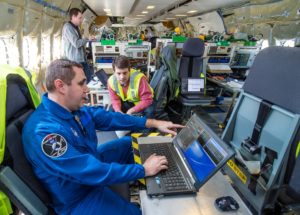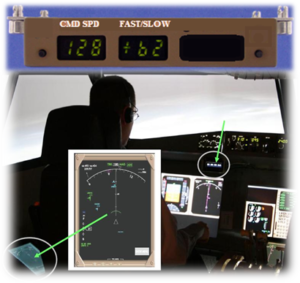
In the National Airspace System (NAS) today, the efficiency of arrivals into high-density terminal areas is constrained by a number of factors. Ideally, arrivals would have 4D trajectories (3D+Time) that are predictable, fuel efficient, and environmentally efficient with reduced delays for passengers during the busiest periods of air traffic. While this is largely possible during off-peak periods, it is unachievable today during peak traffic.
Flight-deck Interval Management(FIM) uses flight deck automation that provides air speeds to pilots allowing them to more accurately space their aircraft behind another aircraft based on an operationally desired spacing goal prescribed by Air Traffic Control(ATC). We have designed, built, and tested a FIM application that uses ADS-B information to calculate speeds that an aircraft can fly to achieve precise inter-aircraft spacing during arrival operations. Our application also includes ground automation enhancements for some operations.
Our FIM human machine interface, procedures, and algorithms are tested in multiple batch and human-in-the-loop simulations with airline pilots. These tests include demonstrations of the FIM on the Boeing 757 EcoDemonstrator aircraft. As part NASA’s ATM Technology Demonstration (ATD-1), tested the integration of FIM with the new Terminal sequencing and spacing (TSAS) decision support tools. We are currently working with the FAA, industry, and airlines to transfer FIM technology and conduct an extensive flight test of FIM avionics prototypes.

We have designed, built, and tested a FIM application that uses ADS-B information to calculate speeds that an aircraft can fly to achieve precise inter-aircraft spacing during arrival operations. Our FIM human machine interface, procedures, and algorithms are tested in multiple batch and human-in-the-loop simulations with airline pilots. These tests include demonstrations of the FIM on the Boeing 757 EcoDemonstrator aircraft. As part NASA’s ATM Technology Demonstration (ATD-1), tested the integration of FIM with the new Terminal sequencing and spacing (TSAS) decision support tools. We are currently working with the FAA, industry, and airlines to transfer FIM technology and conduct an extensive flight test of FIM avionics prototypes.
As part of ATD-1, industry and a major airline are sharing the cost of the FIM avionics prototype development and flight test. FIM is the foundation of the FAA surveillance and Broadcasting services (SBS) interval management for Arrival, Approach and Cruise and Advanced Interval Management ConOps. As of now, we have ongoing FIM international collaboration with NLR and KDC under Airspace systems program with software requested by NLR, ENRI, Honeywell, Boing, MITRE, R&T Europe ACSS, and IAI.